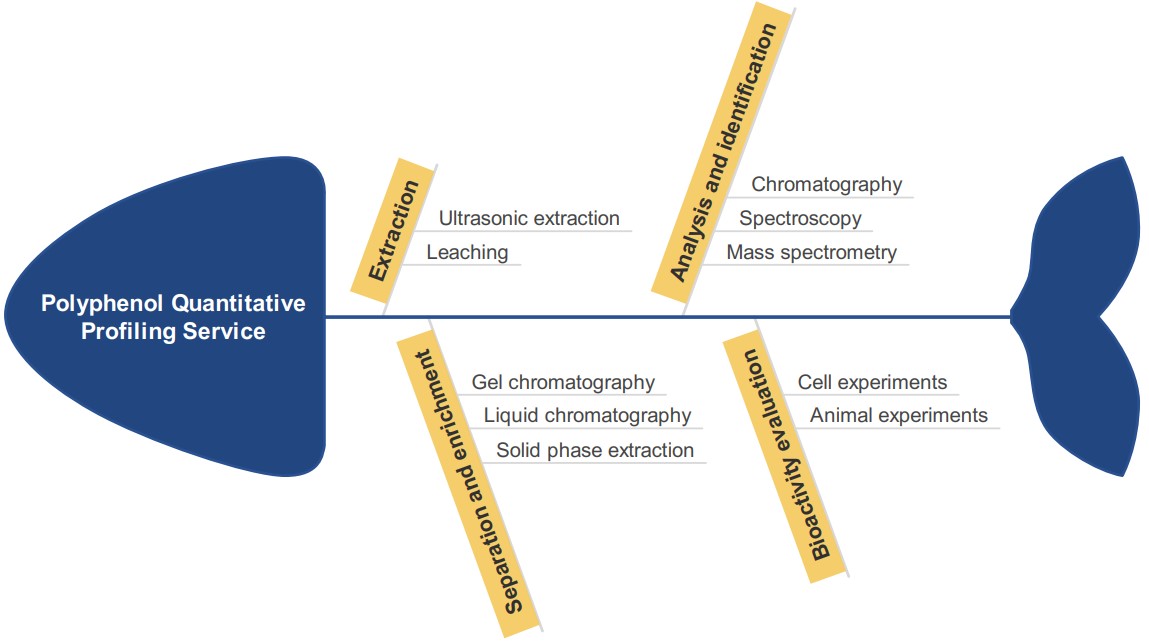Polyphenol Quantitative Profiling Service
Personalized Polyphenol Analysis Service at Creative Biolabs
Polyphenol is a class of compounds that are widely found in nature. It has various potential biological activities and health benefits. It is used as a natural antioxidant, pigment, preservative, etc. There are also many types of polyphenol compounds in biomass and seaweed. The analysis of polyphenols in biomass helps us better understand their types, content, and structural characteristics, thereby providing important data support for research in the fields of medicine and food science. Creative Biolabs has rich project practice experience and successful cases and can analyze Polyamine, polyphenol, and Terpene in biomass of different types and sources, and solve various complex problems that may arise.
For polyphenols, the analysis process usually involves the following steps:
We extract polyphenol from various biomass samples by ultrasonic extraction, leaching, etc.
-
Separation and enrichment
The extracted mixture may contain a variety of compounds, and we need to separate the polyphenols in it. Commonly used separation techniques include gel chromatography, liquid chromatography, solid phase extraction, etc. We will also concentrate on the separated samples to increase the detection sensitivity according to the sample situation.
-
Analysis and identification
We use various analytical techniques to characterize and identify the separated polyphenol. Such as spectroscopy, mass spectrometry (MS), etc. In addition, we also perform quantitative analysis of polyphenols by chromatography and mass spectrometry. We determine the content and type of different polyphenols in the sample by comparing the retention time, peak area, and other data of the sample with the standard. For example caffeic acid, chlorogenic acid, scopolin, rutin, scopoletin, etc. During the entire analysis process, we strictly perform quality control, using standard curves, repeated measurements, and other methods to ensure data accuracy and reliability.
We use in vitro cell experiments and animal experiments to comprehensively evaluate the biological activity and potential health benefits of polyphenols, provide important information for research in related fields, and provide a reference for the development of bioactive products.

Creative Biolabs has a professional analysis team, and our scientists use a variety of advanced analytical equipment to accurately and efficiently analyze polyphenol. Moreover, we also provide personalized analysis plans and reports according to your needs to provide support and assistance for your research and application. If you need a high-level polyphenol analysis service, we will be your reliable partner, please contact us as soon as possible to get a detailed quotation.
Published data
Moringa oleifera is a widely used medicinal plant. Its leaves, stems, seeds and roots have been found to have a variety of biological activities, including anti-inflammatory, antibacterial, antioxidant, and antihypertensive effects. Among them, phenolic and flavonoid compounds in Moringa oleifera leaves are considered to be the source of its high antioxidant activity. To study the effects of different environmental factors on the target polyphenolic compounds in Moringa oleifera leaves, the authors used ultrasound-assisted technology to extract polyphenolic compounds such as chlorogenic acid, catechins, gallic acid, and quercetin from Moringa oleifera leaves collected in different seasons. The antioxidant activity, total phenolic content (TPC), and total flavonoid content (TFC) of the extracts were then determined, and all 29 polyphenolic compounds were identified by ultra-performance liquid chromatography-electrospray ionization mass spectrometry (UPLC-ESI-QTOFMS). The study found that the season had a significant effect on the polyphenol content, with a trend of autumn > winter > summer > spring, indicating that Moringa oleifera leaves collected in autumn and winter had higher antioxidant activity. Therefore, the authors recommended summer and autumn as the best harvesting seasons. Although winter also provided a large amount of active substances, there was less biomass at this time.
 Fig.1 TFC and TPC contents of Moringa oleifera leaves in different seasons.1, 2
Fig.1 TFC and TPC contents of Moringa oleifera leaves in different seasons.1, 2
FAQs
Q1: What technologies do you use for polyphenol analysis? What are their advantages and disadvantages?
A1: We may use high-performance liquid chromatography (HPLC), mass spectrometry, and other technologies for polyphenol analysis. HPLC provides high sensitivity and accuracy, but it takes a long time to analyze; mass spectrometry provides compound structure information, but the cost is higher.
Q2: How does the pricing for polyphenol analysis services work?
A2: Our pricing is typically based on the number and type of analyses requested. We can provide you with a detailed quote according to your specific needs.
Q3: Can you detect specific types of polyphenols in my sample?
A3: Yes, our analysis can identify and quantify various classes of polyphenols, including flavonoids, phenolic acids, tannins, etc.
Customer Review
The Professional Team Provides Guidance And Suggestions
"Creative Biolabs's expert team is very friendly and professional and gave a lot of advice and guidance throughout the analysis process. Thank you for helping us solve the problem of polyphenol analysis!"
Rich Reports Help to Clearly Understand The Content of Polyphenols
"The report provided by Creative Biolabs contains rich data and charts, which allows us to better understand the content and types of polyphenols in biomass. Thank you for your service!"
References
-
Ralepele, F. M., et al. "UPLC-DAD-QTOF-MS/MS analysis of targeted poly-phenolic compounds from Moringa oleifera leaves as function of seasonal responses." South African Journal of Botany 143 (2021): 107-115.
-
Under Open Access license CC BY 4.0, without modification.
For Research Use Only.
Related Services


 Fig.1 TFC and TPC contents of Moringa oleifera leaves in different seasons.1, 2
Fig.1 TFC and TPC contents of Moringa oleifera leaves in different seasons.1, 2

